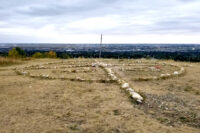Heat and storms having worrying effect on local crops
By Herald on July 6, 2021.
 A grasshopper clings to a stalk of grain growing in a dryland field near Lethbridge. Herald photo by Al Beeber
A grasshopper clings to a stalk of grain growing in a dryland field near Lethbridge. Herald photo by Al BeeberTim Kalinowski – Lethbridge Herald
Local farmers and ranchers are struggling with drought as high temperatures prematurely age crops, deteriorate pastures, draw down local reservoirs, and create the potential for devastating storms.
“The concern is there wasn’t a lot of soil moisture when farmers seeded this spring,” explains Lethbridge County supervisor of agriculture services Gary Secrist. “And obviously the continuing drought is offering some concerns … People are definitely prepping for a harvest we think can be starting at the end of July.”
“Outside of the irrigation areas there is a great deal of concern,” agrees Potato Growers of Alberta executive director Terence Hochstein. “It is very obvious what is happening outside of irrigation- the crops are burning up.”
And even for those potato fields under irrigation, says Hochstein, the record-breaking heat is taking a toll.
“This heat has definitely affected our potato crops,” he confirms. “You drive down the road, you look at it, it looks nice and green, and it is starting to flower. But what this heat has done is it has caused these plants to drop their first sets. As the potato plant starts to mature and grow it starts to grow baby tubers, but this heat has caused such extreme stress for this crop it has basically aborted its first set. So now (the crop) has got to start all over again.”
Hochstein says potato farmers under irrigation are now staring down the two horns of a dilemma as they hope there will be enough time in the growing season to get a mature crop off before the first frosts set in this fall, and secondly, that there will be high enough water levels in local reserves to sustain the pace of watering needed to accomplish that.
“If it continues to be hot like this there are some concerns whether or not we can continue to keep up with our watering schedules,” he says. “It’s 24/7. The reservoirs are on the lower end down here. The Chins, the Forty Miles, they are going down rapidly.”
Out in Pincher Creek country, MD of Pincher Creek Councillor Quentin Stevick says the terrible heat has also taken a huge toll on hay fields.
“The crops aren’t going to be what we seen last year, and our hay, we have it baled now, it is maybe two-thirds of what we have on a five-year average,” he explains.
Stevick says heavy dews in his region have helped somewhat, but they are not a replacement for the substantial rains that are needed to get another cut of hay this summer.
It’s the same story in Cardston County, confirms Deputy Reeve Jim Bester.
“We have less yields on our hay crops because of the heatwave that has gone through,” he says. “Our hay crop, we just cut it. And we just started to rake it and bale it. But it was probably 60 per cent of what it was last year because of the heat.”
Bester does worry the extreme heat will produce more severe summer storms the longer it lasts. His region of Cardston County experienced some sporadic areas of hail damage on Monday night. The same storm that reportedly caused floods and widespread damage in the community of Cardston, he confirms, only caused some minor equipment and crop damage on his land.
“All in all it wasn’t as devastating as what we have had in past years,” he says. “It was fairly intense, but the size of hail was corn-sized to marble. In our area I haven’t heard of any major damage, and I think the crops will survive it.”
Stevick, who lives near Bester and not too far from the Waterton Dam, also experienced only minor hail damage on his property, but he has spoken with guys who have seen a lot worse damage.
“Between Cardston coming up on Hwy. 2, and then coming up on Hwy. 505, to the Waterton Dam, there was extensive crop damage because of the hailstorm,” Stevick confirms.
Hochstein, who farms near Twin Butte, says his family’s and their neighbours’ crops were wiped out by Monday’s hailstorm.
“There is nothing left,” he says. “It’s just one more thing we have to deal with. As an agricultural producer, you have absolutely zero control over Mother Nature. You just hope for the best every year you put your crops in, and just let the chips fall where they may.”
Follow @TimKalHerald on Twitter
21-20




